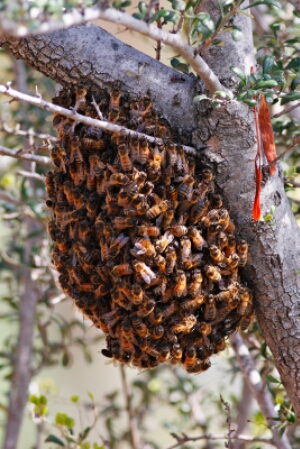
On Tuesday afternoon (9/29/2015) officers responded to an overturned truck in Garvin County, Oklahoma. This had a difference, though, as the truck was carrying bee hives. You’ve heard of situations when police show up to help at a scene and find those they want to help turning on them? That was the experience of officer Carl Zink who found himself trapped inside his cruiser while thousands of unhappy bees swarmed his vehicle.
What did he do? He did what many of us would do with a once-in-a-lifetime experience. He filmed it on his phone. Here is dramatic video.
Incredibly, Officer Zink was only stung once. Beekeepers showed up to cleanse the vehicle and get the bees safely reorganized.
Were the bees really attacking his truck in anger? Probably not. When bees have trouble with their hive they will swarm. The traffic incident probably put the bees into a defensive mode in the beginning, but very quickly their priority became to find a new home.

Photo by fir0002 | flagstaffotos.com.au [GFDL 1.2], via Wikimedia Commons
In fact, bee expert Thomas Seeley says that honeybees are at their safest when swarming. He explains that a swarm of bees has no home to defend, they are simply in transition, so they are less likely to be aggressive. If you don’t bother them, they won’t bother you.
If you encounter a warm of bees you should do what they did in Oklahoma. Contact a beekeeper who can deal with them safely. Our bees are currently in decline with a phenomenon called colony collapse disorder. Because of the importance of the bee in agriculture (and much of our other plant life) loss of bees would have a serious impact on our future. Any time you can save a colony of bees you help to maintain and grow that population. Look for a local beekeeper association for help.
Just like our friends, the spiders (who may rain down upon us or build giant creepy webs) bees have a special place on the planet. They may be weird, but they are important.


